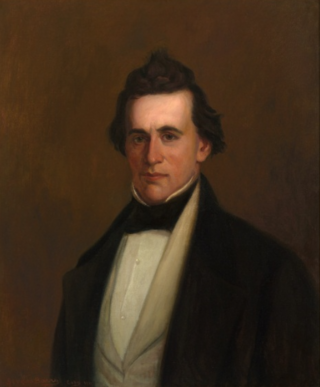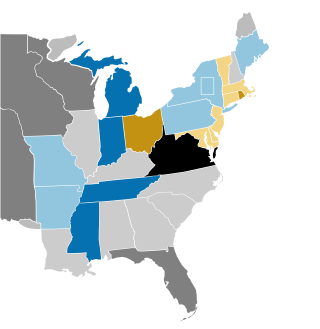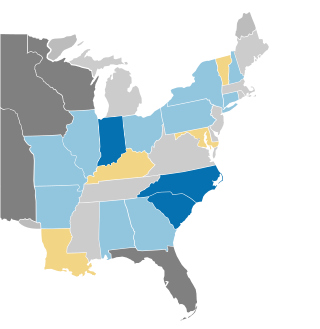Related Research Articles

The 27th United States Congress was a meeting of the legislative branch of the United States federal government, consisting of the United States Senate and the United States House of Representatives. It met in Washington, D.C., between March 4, 1841, and March 4, 1843, during the one-month presidency of William Henry Harrison and the first two years of the presidency of his successor, John Tyler. The apportionment of seats in the House of Representatives was based on the 1830 United States census. Both chambers had a Whig majority, making the 27th Congress the only Whig-controlled Congress of the Second Party System.

John Parker Hale was an American politician and lawyer from New Hampshire. He served in the United States House of Representatives from 1843 to 1845 and in the United States Senate from 1847 to 1853 and again from 1855 to 1865. He began his congressional career as a Democrat, but helped establish the anti-slavery Free Soil Party and eventually joined the Republican Party.

John Bell was an American politician, attorney, and planter who was a candidate for President of the United States in the election of 1860.

James Chamberlain Jones was an American politician who served as the tenth governor of Tennessee from 1841 to 1845, and as a United States Senator from Tennessee from 1851 to 1857. A Whig, Jones twice defeated future U.S. President James K. Polk for the governorship, in 1841 and 1843. He was the first native-born Tennessean to be elected governor of the state.

Isham Green Harris was an American and Confederate politician who served as the 16th governor of Tennessee from 1857 to 1862, and as a U.S. senator from 1877 until his death. He was the state's first governor from West Tennessee. A pivotal figure in the state's history, Harris was considered by his contemporaries the person most responsible for leading Tennessee out of the Union and aligning it with the Confederacy during the Civil War.

John D. White was an American lawyer and politician who was the 15th speaker of the United States House of Representatives from 1841 to 1843. A member of the Whig Party, he represented Kentucky in the United States House of Representatives from 1835 to 1845. He was also a member of the Kentucky House of Representatives in 1832.

Spencer Jarnagin was a United States Senator from Tennessee from 1843 to 1847.

Party divisions of United States Congresses have played a central role on the organization and operations of both chambers of the United States Congress—the Senate and the House of Representatives—since its establishment as the bicameral legislature of the Federal government of the United States in 1789. Political parties had not been anticipated when the U.S. Constitution was drafted in 1787, nor did they exist at the time the first Senate elections and House elections occurred in 1788 and 1789. Organized political parties developed in the U.S. in the 1790s, but political factions—from which organized parties evolved—began to appear almost immediately after the 1st Congress convened. Those who supported the Washington administration were referred to as "pro-administration" and would eventually form the Federalist Party, while those in opposition joined the emerging Democratic-Republican Party. Heidi’s

The 1837 United States Senate election in New York was held on February 7, 1837, by the New York State Legislature to elect a U.S. Senator to represent the State of New York in the United States Senate.

The 1839—1840 United States Senate election in New York was held on February 5, 1839 and January 14, 1840. Incumbent Senator Nathaniel P. Tallmadge was re-elected to a second term in office over scattered opposition.

The 1843 United States Senate election in New York was held on February 7, 1843, by the New York State Legislature to elect a U.S. Senator to represent the State of New York in the United States Senate.

The 1845 United States Senate special election in New York was held on January 18, 1845 by the New York State Legislature to elect two U.S. Senators to represent the State of New York in the United States Senate. The regular 1845 United States Senate election in New York was held on February 4, 1845, to elect a U.S. Senator to represent the State of New York in the United States Senate.

The 1852–53 United States Senate elections were held on various dates in various states, coinciding with the 1852 presidential election. As these U.S. Senate elections were prior to the ratification of the Seventeenth Amendment in 1913, senators were chosen by state legislatures. Senators were elected over a wide range of time throughout 1852 and 1853, and a seat may have been filled months late or remained vacant due to legislative deadlock. In these elections, terms were up for the senators in Class 2.

The 1844–45 United States Senate elections were held on various dates in various states, coinciding with James K. Polk's election. As these U.S. Senate elections were prior to the ratification of the Seventeenth Amendment in 1913, senators were chosen by state legislatures. Senators were elected over a wide range of time throughout 1844 and 1845, and a seat may have been filled months late or remained vacant due to legislative deadlock. In these elections, terms were up for the senators in Class 1.

The 1842–43 United States Senate elections were held on various dates in various states. As these U.S. Senate elections were prior to the ratification of the Seventeenth Amendment in 1913, senators were chosen by state legislatures. Senators were elected over a wide range of time throughout 1842 and 1843, and a seat may have been filled months late or remained vacant due to legislative deadlock. In these elections, terms were up for the senators in Class 3.

The 1840–41 United States Senate elections were held on various dates in various states. As these U.S. Senate elections were prior to the ratification of the Seventeenth Amendment in 1913, senators were chosen by state legislatures. Senators were elected over a wide range of time throughout 1840 and 1841, and a seat may have been filled months late or remained vacant due to legislative deadlock. In these elections, terms were up for the senators in Class 2.

The 1838–39 United States Senate elections were held on various dates in various states. As these U.S. Senate elections were prior to the ratification of the Seventeenth Amendment in 1913, senators were chosen by state legislatures. Senators were elected over a wide range of time throughout 1838 and 1839, and a seat may have been filled months late or remained vacant due to legislative deadlock. In these elections, terms were up for the senators in Class 1.

The 1836–37 United States Senate elections were held on various dates in various states. As these U.S. Senate elections were prior to the ratification of the Seventeenth Amendment in 1913, senators were chosen by state legislatures. Senators were elected over a wide range of time throughout 1836 and 1837, and a seat may have been filled months late or remained vacant due to legislative deadlock. In these elections, terms were up for the senators in Class 3.

The 1844 United States elections elected the members of the 29th United States Congress, and took place during the Second Party System in the midst of the debate over whether to annex Texas. Texas and Iowa joined the union during the 29th Congress. Democrats retained control of the House and took back control of the presidency and the Senate, re-establishing the dominant position the party had lost in the 1840 election.
In 1841, Spencer Jarnagin was nominated for U.S. Senator by the Whig caucus in the Tennessee General Assembly. However, some of the Democrats in the legislature decided that no senator would be preferable to a Whig. Known as the "Immortal Thirteen" by Tennessee Democrats, they refused to allow a quorum on the issue. By the time Jarnagin was eventually elected to the seat and sworn in, over two and half years, almost half of the term, had elapsed. Jarnagin finally assumed office on October 17, 1843.
References
- ↑ Bergeron, Paul H. (June 1963). "The Election of 1843: A Whig Triumph in Tennessee". Tennessee Historical Quarterly . 22 (2): 123–136. JSTOR 42621623.